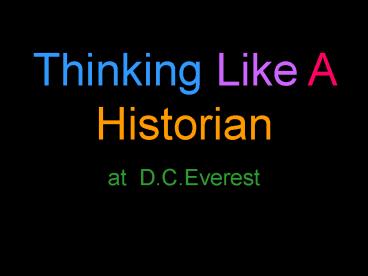Thinking Like A Historian - PowerPoint PPT Presentation
1 / 25
Title:
Thinking Like A Historian
Description:
Thinking Like A Historian at D.C.Everest What Is History? History is a discipline: a way of thinking that encourages students to analyze historical evidence, evaluate ... – PowerPoint PPT presentation
Number of Views:195
Avg rating:3.0/5.0
Title: Thinking Like A Historian
1
Thinking Like A Historian at D.C.Everest
2
WOW!
3
Examine testing at various levels 8th grade
WKCE 10th grade WKCE AP Tests DBQs
4
Thinking Like a Historian
Teachers creating a foundation that can
connect and develop students curiosity about
and understanding of history through the use of
a common language.
5
What Is History?
- History is a discipline a way of thinking that
encourages students to analyze historical
evidence, evaluate it, and then demonstrate their
understanding of that evidence. - The best history courses engage students in the
study of historical artifacts and documents
which are often contradictory and muddled from
which they draw their own interpretations or
conclusions.
6
- Middle School, Junior High , and even H.S.
students accept sources as gospel as the truth. - Students need the power of discernment more than
ever! - In a rapidly changing world in which
historical ignorance seems to be the rule rather
than the exception, there is no more important
discipline for our students to practice , than
history.
7
Questions
- All history starts with questions?????
- Take on the persona of a detective to examine the
evidence. - The evidence comes in two forms primary and
secondary sources.
8
How do Historians Use Historical Sources?
- There is a fundamental difference between looking
for answers in the sources and constructing
answers from the sources. - Constructing answers is the final stage of Doing
History - Building an interpretation based on evidence is
the defining characteristic of history.
9
Drawing Conclusions Making Interpretations
- Historical conclusions must be supportable by the
historical record AND take into consideration
sometimes conflicting perspectives and
experiences in that record.
10
Historical Categories of Inquiry
- These are patterns that help us organize both the
questions we ask of the past and the answers we
construct. - These categories of inquiry and analysis provide
the patterns that help us make sense of the past. - It also gives us a common language.
11
Evaluating Sources
- Not all historical sources are equal
- Consider ways to assess the validity of the
sources - Use AAPARTS ( to be explained later by JEFF)
- Multiple sources are needed in order to fully
understand the complexity and importance of any
historical event , era, person or group. - DBQs provide multiple sources for students to
use to draw conclusions and make interpretations.
12
Thinking Like A Historian Rethinking History
Instruction was written by Bobbie Malone and
Nikki Mandell.
13
(No Transcript)
14
(No Transcript)
15
(No Transcript)
16
(No Transcript)
17
Cause-Effect Graphic Organizers
18
(No Transcript)
19
(No Transcript)
20
(No Transcript)
21
(No Transcript)
22
(No Transcript)
23
(No Transcript)
24
(No Transcript)
25
(No Transcript)































